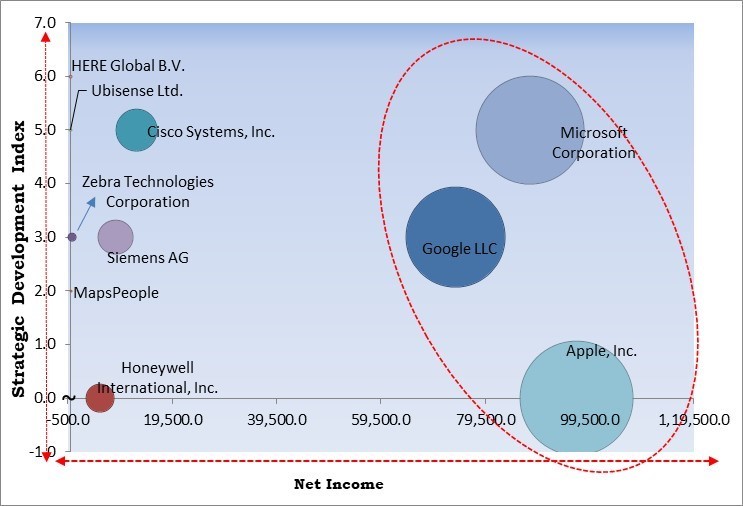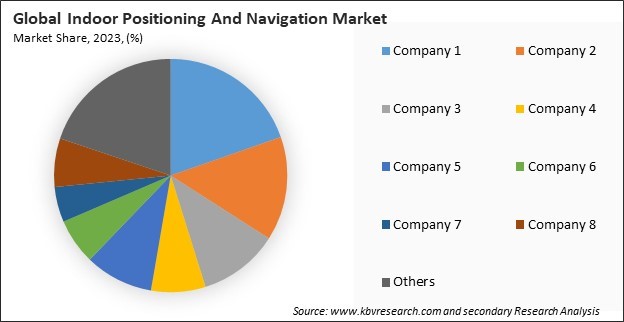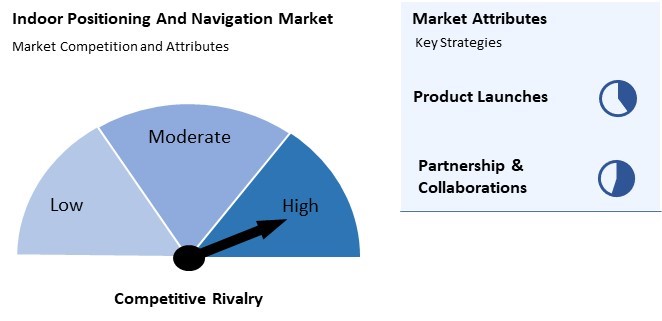“Global Indoor Positioning And Navigation Market to reach a market value of USD 208.6 Billion by 2031 growing at a CAGR of 37.2%”
The Global Indoor Positioning And Navigation Market size is expected to reach $208.6 billion by 2031, rising at a market growth of 37.2% CAGR during the forecast period.
Europe is characterized by its strong emphasis on innovation, sustainability, and smart city initiatives. The European Union's funding programs, such as Horizon 2020, have supported research and development in indoor positioning technologies. Countries like Germany, the United Kingdom, and France are at the forefront of adopting these technologies across various sectors, including retail, healthcare, logistics, and manufacturing. Consequently, the European region would acquire nearly 30% of the total market share by 2031.

The major strategies followed by the market participants are Partnerships as the key developmental strategy to keep pace with the changing demands of end users. For instance, in March, 2024, Ubisense partnered with Quuppa, a market leader in providing accurate, real-time location information for indoor and local areas. This partnership aligns with Ubisense’s strategy to integrate cutting-edge location and identification technologies into its open and sensor-agnostic SmartSpace software platform. Moreover, in January, 2024, HERE Technologies entered into a partnership with what3words, enabling customers of HERE's Location Services application programming interfaces (APIs) to utilize the global addressing system developed by the UK-based company.
Based on the Analysis presented in the KBV Cardinal matrix; Google LLC, Apple, Inc., and Microsoft Corporation are the forerunners in the Market. In July, 2024, Microsoft teamed up with TomTom to integrate TomTom’s maps and traffic data into its location-based services. TomTom’s Orbis Maps and traffic services will be licensed globally by Microsoft and combined with Microsoft's AI capabilities to enhance offerings in the automotive, logistics, and mobility markets. Hosting TomTom’s services on Microsoft Azure ensures seamless integration with Microsoft's technology. Companies such as Siemens AG, Cisco Systems, Inc. and Honeywell International, Inc. are some of the key innovators in Market.

Innovations in Bluetooth Low Energy (BLE), Wi-Fi, and Ultra-Wideband (UWB) significantly enhance indoor positioning systems' accuracy, reliability, and efficiency, making them increasingly attractive to various industries. Wi-Fi technology has also seen significant advancements that contribute to the effectiveness of indoor positioning systems. Hence, these advancements are propelling the growth of the market.
The pervasive use of mobile applications and smartphones has established a robust platform for deploying indoor positioning technologies, thereby simplifying the process of businesses and consumers accessing and utilizing these systems. Smartphones come equipped with multiple sensors, including GPS, accelerometers, gyroscopes, and magnetometers, which are essential for indoor positioning. Thus, the proliferation of smartphones and mobile applications has significantly driven the adoption of indoor navigation solutions.
Deploying these sophisticated systems often necessitates a significant financial investment in various components and infrastructure upgrades. These high implementation costs especially impact smaller businesses or institutions with limited budgets. Hence, the high cost of implementation is a significant factor hampering the growth of the market.

The leading players in the market are competing with diverse innovative offerings to remain competitive in the market. The above illustration shows the percentage of revenue shared by some of the leading companies in the market. The leading players of the market are adopting various strategies in order to cater demand coming from the different industries. The key developmental strategies in the market are Acquisitions, and Partnerships & Collaborations.
By application, the market is divided into asset & personnel tracking, location-based analytics, navigation & maps, and others. The location-based analytics segment garnered 27% revenue share in the market in 2023. The location-based analytics segment is growing by leveraging data from indoor positioning systems to provide actionable insights into movement patterns, behaviors, and interactions within indoor spaces.
Based on end use, the market is segmented into healthcare, retail, manufacturing, travel & hospitality, office spaces, public spaces, logistics & warehouses, and others. The healthcare segment acquired an 18% revenue share in the market in 2023. Hospitals and healthcare facilities utilize indoor positioning systems to improve patient care, streamline operations, and enhance asset management.

Based on component, the market is characterized into software, hardware, and service. The service segment procured 24% revenue share in the market in 2023. The complexity of implementing indoor positioning technologies necessitates specialized knowledge and skills to ensure correct installation, seamless integration with existing infrastructure, and optimal system performance.
On the basis of technology, the market is classified into ultra-wideband technology, Bluetooth low energy, Wi-Fi, and others. The Wi-Fi segment recorded 27% significant revenue share in the market in 2023. Wi-Fi-based systems leverage existing wireless network infrastructure to accurately determine the location of devices.
Free Valuable Insights: Global Indoor Positioning And Navigation Market size to reach USD 208.6 Billion by 2031
Region-wise, the market is analyzed across North America, Europe, Asia Pacific, and LAMEA. The North America segment garnered 37% revenue share in the market in 2023. This dominance can be ascribed to various factors, such as the region's early adoption of innovative technologies, high investment in research and development, and an advanced technological ecosystem.

The competition in the market is intense, driven by the rising demand for accurate, real-time location tracking in industries like retail, healthcare, and logistics. Key players focus on innovations like Bluetooth Low Energy (BLE) beacons, ultra-wideband (UWB) technology, and AI-driven solutions to differentiate and capture market share.
| Report Attribute | Details |
|---|---|
| Market size value in 2023 | USD 16.8 Billion |
| Market size forecast in 2031 | USD 208.6 Billion |
| Base Year | 2023 |
| Historical Period | 2020 to 2022 |
| Forecast Period | 2024 to 2031 |
| Revenue Growth Rate | CAGR of 37.2% from 2024 to 2031 |
| Number of Pages | 351 |
| Number of Tables | 513 |
| Report coverage | Market Trends, Revenue Estimation and Forecast, Segmentation Analysis, Regional and Country Breakdown, Competitive Landscape, Market Share Analysis, Porter’s 5 Forces Analysis, Company Profiling, Companies Strategic Developments, SWOT Analysis, Winning Imperatives |
| Segments covered | Component, Technology, Application, End Use, Region |
| Country scope |
|
| Companies Included | Zebra Technologies Corporation, Cisco Systems, Inc., Google LLC (Alphabet Inc.), Honeywell International, Inc., Microsoft Corporation, MapsPeople, Siemens AG, HERE Global B.V., IndoorAtlas Ltd., Ubisense Ltd. and Apple, Inc. |
By Component
By Technology
By Application
By End Use
By Geography
This Market size is expected to reach $208.6 billion by 2031.
Continuous advancements in technologies are driving the Market in coming years, however, High cost of implementation restraints the growth of the Market.
Zebra Technologies Corporation, Cisco Systems, Inc., Google LLC (Alphabet Inc.), Honeywell International, Inc., Microsoft Corporation, MapsPeople, Siemens AG, HERE Global B.V., IndoorAtlas Ltd., Ubisense Ltd. and Apple, Inc.
The expected CAGR of this Market is 37.2% from 2024 to 2031.
The Software segment generated the highest revenue in the Market by Component in 2023; thereby, achieving a market value of $81.3 billion by 2031.
The North America region dominated the Market by Region in 2023, and would continue to be a dominant market till 2031; thereby, achieving a market value of $75 billion by 2031.
Our team of dedicated experts can provide you with attractive expansion opportunities for your business.

 Drivers
Drivers
 Restraints
Restraints
 Opportunities
Opportunities
 Challenges
Challenges
